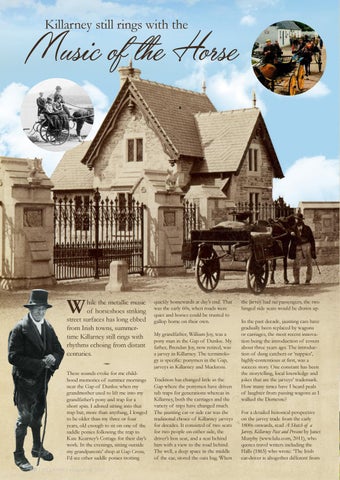Killarney still rings with the
Music of the Horse
hile the metallic music of horseshoes striking street surfaces has long ebbed from Irish towns, summertime Killarney still rings with rhythms echoing from distant centuries. These sounds evoke for me childhood memories of summer mornings near the Gap of Dunloe when my grandmother used to lift me into my grandfather’s pony and trap for a short spin. I adored sitting into that trap but, more than anything, I longed to be older than my three or four years, old enough to sit on one of the saddle ponies following the trap to Kate Kearney’s Cottage for their day’s work. In the evenings, sitting outside my grandparents’ shop at Gap Cross, I’d see other saddle ponies trotting 48
I KILLARNEY Magazine
2021
quickly homewards at day’s end. That was the early 60s, when roads were quiet and horses could be trusted to gallop home on their own. My grandfather, William Joy, was a pony man in the Gap of Dunloe. My father, Brendan Joy, now retired, was a jarvey in Killarney. The terminology is specific: ponymen in the Gap, jarveys in Killarney and Muckross. Tradition has changed little in the Gap where the ponymen have driven tub traps for generations whereas in Killarney, both the carriages and the variety of trips have changed much. The jaunting car or side car was the traditional choice of Killarney jarveys for decades. It consisted of two seats for two people on either side, the driver’s box seat, and a seat behind him with a view to the road behind. The well, a deep space in the middle of the car, stored the oats bag. When
the jarvey had no passengers, the two hinged side seats would be drawn up. In the past decade, jaunting cars have gradually been replaced by wagons or carriages, the most recent innovation being the introduction of covers about three years ago. The introduction of dung catchers or ‘nappies’, highly-contentious at first, was a success story. One constant has been the storytelling, local knowledge and jokes that are the jarveys’ trademark. How many times have I heard peals of laughter from passing wagons as I walked the Demesne? For a detailed historical perspective on the jarvey trade from the early 1800s onwards, read A Sketch of a Jarvey, Killarney Past and Present by Janet Murphy (www.lulu.com, 2011), who quotes travel writers including the Halls (1865) who wrote: ‘The Irish car-driver is altogether different from


















